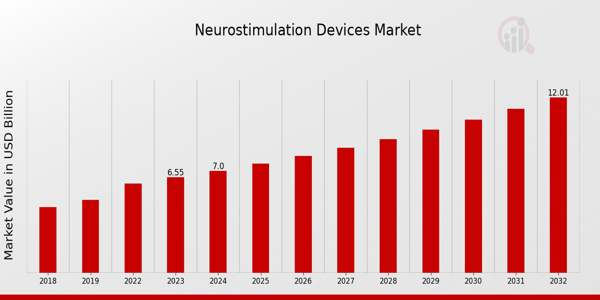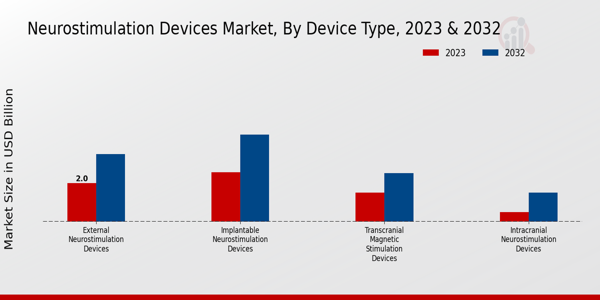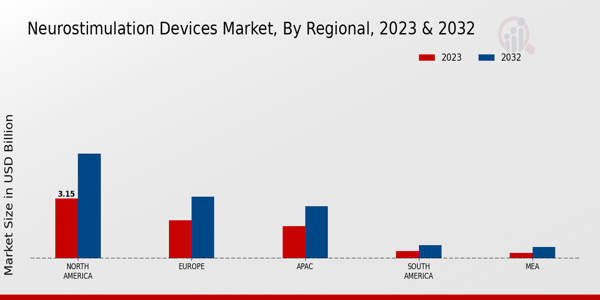Global Neurostimulation Devices Market Overview
As per MRFR analysis, the Neurostimulation Devices Market Size was estimated at 7.83 (USD Billion) in 2023.The Neurostimulation Devices Market Industry is expected to grow from 8.3(USD Billion) in 2024 to 15.8 (USD Billion) by 2035. The Neurostimulation Devices Market CAGR (growth rate) is expected to be around 6.02% during the forecast period (2025 - 2035).
Key Neurostimulation Devices Market Trends Highlighted
The Neurostimulation Devices Market is undergoing remarkable changes due to the escalation in the need for newer therapeutic solutions for the treatment of neurological disorders. One of the most important market reasons is the adopting of neurostimulation devices by health care providers due to the increasing rates of chronic pain issues, epilepsy, and movement disorders, like Parkinson’s disease. Moreover, increased awareness about the advantages of modern techniques in managing pain has motivated both patients and practitioners to investigate these new methodologies. There is a lot of scope in the market, especially in the growth of the neurostimulators market which goes beyond the neurological uses of these devices.
Advanced devices for helping with mental disorders like depression and anxiety could diversify revenue streams quicker than expected. Besides, the development of new neurostimulation technologies, including neuromodulation and wireless devices, gives businesses the chance to improve their product and patient care. Recent changes to the market include the shift towards personal medicine, where patient-specific neurostimulation instruments are tailored for individual use, making them more effective and satisfying for the patients. The incorporation of digital health tools is also influencing the market because remote access monitoring and real-time analytics of data are becoming vital in neurostimulation therapy.
Moreover, the change to value-based care models further incentivizes clinicians to apply neurostimulation therapies that have clear clinical evidence supporting their application. While the global population continues to age alongside the increasing prevalence of neurologic conditions, the need for neurostimulation devices is anticipated to surge which presents opportunities in this continuously evolving and dynamic market.

Neurostimulation Devices Market Drivers
Rising Prevalence of Neurological Disorders
The Neurostimulation Devices Market is significantly motivated by the rising prevalence of neurological disorders, including epilepsy, Parkinson's disease, and migraine. According to the World Health Organization, neurological conditions affect approximately 1 in 6 individuals globally, highlighting the increasing population facing these challenges. Notably, organizations such as the American Epilepsy Society report that epilepsy affects around 50 million individuals worldwide.
This growing patient base creates a heightened demand for neurostimulation devices as therapeutic options to manage these disorders. The ongoing Research and Development initiatives from leading companies in the neurostimulation domain further emphasize an innovative approach to tackle these conditions, ultimately propelling market growth in the Neurostimulation Devices Market Industry.
Technological Advancements in Neurostimulation Devices
The Neurostimulation Devices Market is being driven forward by continuous technological advancements. Recent innovations, including closed-loop systems and wireless connectivity in neurostimulation devices, are transforming patient outcomes and healthcare delivery. The introduction of novel materials and improved sensor technologies has led to effective treatments for chronic pain and movement disorders.
Organizations such as the IEEE (Institute of Electrical and Electronics Engineers) recognize the crucial role of emerging technologies in enhancing device functionality and patient experiences.With these advancements expected to contribute significantly to market expansion, the Neurostimulation Devices Market Industry stands to benefit from increased effectiveness and patient satisfaction.
Growing Aging Population
The aging global population is another crucial driver impacting the Neurostimulation Devices Market. By 2050, the United Nations projects the number of individuals aged 60 and older to reach approximately 2.1 billion, significantly elevating the incidence rate of neurodegenerative diseases such as Alzheimer’s and dementia. This demographic change heightens the dependency on medical technologies, especially neurostimulation devices for rehabilitation and symptom management.
Established organizations like the World Health Organization emphasize the pressing need to improve care systems for the elderly and highlight trends that showcase the rise of age-related health issues. As a result, we are likely to see a notable increase in market demand within the Neurostimulation Devices Market Industry as healthcare providers adapt to serve this growing demographic.
Increased Investment in Neurotechnology R
Investment in research and development (R) within the neurotechnology sector is rapidly increasing, fuelling growth in the Neurostimulation Devices Market. Governments and private stakeholders have been allocating substantial funds to innovative research projects, which is vital for developing new therapies and technologies.
The National Institute of Health (NIH) has noted an increase in R funding for neurological disorders, with an investment of over 2 billion USD annually for research programs focused on brain-related technologies.Such funding efforts from esteemed organizations propel the development of next-generation neurostimulation devices, ensuring that the Neurostimulation Devices Market Industry keeps pace with the evolving healthcare needs and challenges.
Neurostimulation Devices Market Segment Insights
Neurostimulation Devices Market Product Type Insights
The Neurostimulation Devices Market shows significant potential with a diverse range of Product Types that cater to various therapeutic needs. In 2024, the market was valued at 8.3 USD Billion and is expected to grow substantially in the coming years. Among these Product Types, the market is segmented into Spinal Cord Stimulators, Deep Brain Stimulators, Transcranial Magnetic Stimulators, and Vagus Nerve Stimulators, each possessing unique advantages and applications. The Spinal Cord Stimulator segment is notably significant, holding a valuation of 3.0 USD Billion in 2024, and expected to grow to 5.6 USD Billion by 2035, reflecting its dominant role in managing chronic pain, particularly in patients suffering from neuropathic disorders.
Deep Brain Stimulators, valued at 2.5 USD Billion in 2024 and projected to reach 4.8 USD Billion by 2035, are essential in treating neurological conditions such as Parkinson's disease and essential tremors, showcasing their importance in improving the quality of life and providing relief to patients. Transcranial Magnetic Stimulators, although smaller in volume with a value of 1.5 USD Billion in 2024 and a future projection of 3.0 USD Billion, are gaining traction in the market for their role in non-invasive treatment for various neuropsychiatric disorders, contributing to an increasing interest in mental health technology.
Lastly, Vagus Nerve Stimulators, valued at 1.3 USD Billion in 2024, are expected to grow to 2.4 USD Billion by 2035, demonstrating their critical role in treating epilepsy and depression, where traditional pharmacological treatments may not provide sufficient relief. This segment of the market is reinforced by advancements in technology and an increasing prevalence of neurological disorders globally, driving the demand for innovative treatment solutions. Moreover, the overall growth of the Neurostimulation Devices Market can be attributed to rising awareness among physicians and patients regarding alternative therapies, technological developments in device functionality and efficacy, and increasing healthcare expenditure aimed at improving treatment outcomes.
Additionally, the growing geriatric population, which tends to experience a higher incidence of neurological conditions, enhances the market's outlook. The increasing emphasis on research and development within the neurostimulation sector, along with policy initiatives aimed at expanding access to advanced medical technologies, further bolster the potential for growth within all Product Types in the Neurostimulation Devices Market.
Each segment plays a strategic role, contributing to the overall progression and diversification of treatment options available to patients suffering from debilitating neurological conditions, reinforcing their relevance in contemporary healthcare settings.

Neurostimulation Devices Market Application Insights
The Neurostimulation Devices Market primarily focuses on the Application segment, which includes Chronic Pain Management, Movement Disorder Treatment, Depression Treatment, and Epilepsy Management. In 2024, the overall market was valued at 8.3 USD Billion and is projected to grow significantly by 2035, reaching a valuation of 15.8 USD Billion. The market is experiencing an upward trend driven by the rising prevalence of neurological disorders and an increasing demand for advanced therapeutic solutions. Chronic Pain Management remains particularly significant, as it addresses a critical health issue affecting a large portion of the population, thereby holding a major portion of the market.
Movement Disorder Treatment encompasses therapies for conditions such as Parkinson's disease, which has seen substantial advancements through neurostimulation techniques, improving patient mobility and quality of life. Depression Treatment is gaining traction, leveraging neurostimulation devices to provide alternative solutions for patients who do not respond well to traditional therapies, thus expanding its importance in mental health care.
Lastly, Epilepsy Management benefits from these devices by enabling better control over seizures, a key factor that contributes to patient safety and wellbeing.The Neurostimulation Devices Market segmentation showcases the diverse applications that advocate for continuous growth and innovation in the industry, aligning with the rising demand for non-invasive treatment options.
Neurostimulation Devices Market End User Insights
The Neurostimulation Devices Market poised for significant growth, valued at 8.3 billion USD in 2024, targeted to reach 15.8 billion USD by 2035. This market segment is primarily driven by an increasing prevalence of neurological disorders and growing acceptance of neurostimulation therapies. Within the End User segment, Hospitals play a crucial role, offering advanced treatment options and access to comprehensive facilities. Specialty Clinics are also an important facet, focusing on personalized care and advanced technologies tailored to individual patient needs.Home Care Settings have gained traction in recent years due to a growing preference for at-home therapies, enhancing patient comfort and improving adherence to treatment protocols.
The Neurostimulation Devices Market is characterized by rapid technological advancements and a shift toward less invasive procedures, presenting opportunities for market expansion. Additionally, favorable government initiatives and increasing healthcare expenditure globally drive this market forward, ensuring that all End User categories, particularly in hospitals and clinics, will continue to dominate with significant contributions to overall market growth.The overall Neurostimulation Devices Market data reflects a strategic focus on both innovation and expansion in facilities to cater to diverse patient needs effectively.
Neurostimulation Devices Market Technology Insights
The Neurostimulation Devices Market is poised for significant growth driven by advancements in Technology, with the overall market reached a valuation of 8.3 USD Billion in 2024 and 15.8 USD Billion by 2035. The market growth is anticipated due to increasing prevalence of neurological disorders, rising demand for minimally invasive treatments, and continuous Research and Development activities. Within the Technology segment, Electrical Stimulation methods, including spinal cord stimulators and deep brain stimulators, play a critical role in pain management and treatment of movement disorders.
Magnetic Stimulation techniques, such as Transcranial Magnetic Stimulation, are gaining traction for their role in addressing depression and anxiety conditions. Additionally, Chemical Stimulation approaches, involving drug delivery systems and other biochemicals, are important for their targeted therapeutic effects on various neurological disorders. The Neurostimulation Devices Market statistics highlight the potential of these technologies in transforming treatment paradigms, enhancing quality of life for patients, and paving the way for innovative solutions in a rapidly evolving industry.
Neurostimulation Devices Market Regional Insights
The Neurostimulation Devices Market reached a notable valuation of 8.3 billion USD in 2024, reflecting significant growth across various regions. North America led the market with a valuation of 3.6 billion USD in 2024, demonstrating a majority holding in the Neurostimulation Devices Market revenue. This region benefits from advanced healthcare infrastructure and increasing adoption of neurostimulation therapies, likely contributing to its expected growth to 7.1 billion USD by 2035. Europe follows as a significant market, valued at 2.5 billion USD in 2024, supported by rising incidences of neurological disorders and favorable regulatory frameworks, with projections putting it at 4.7 billion USD by 2035.
The Asia-Pacific (APAC) region, valued at 1.7 billion USD in 2024, is projected to grow to 3.5 billion USD, spurred by improving healthcare access and a growing aging population, hence representing a crucial growth driver. South America, with a valuation of 0.3 billion USD and the Middle East Africa (MEA) at 0.2 billion USD in 2024, both depict smaller segments of the Neurostimulation Devices Market, but are emerging with potential opportunities as healthcare systems develop. The market statistics highlight an overall positive trend across all regions, presenting various dynamics and opportunities in the evolving landscape of neurostimulation therapies.

Neurostimulation Devices Market Key Players and Competitive Insights
The Neurostimulation Devices Market has witnessed substantial growth driven by the increasing prevalence of neurological disorders, advancements in technology, and the growing demand for innovative therapeutic solutions. Competitive insights in this sector reveal a dynamic landscape characterized by strategic collaborations, mergers, and innovative product developments among leading market players. Companies are focusing on enhancing their product portfolios, improving device efficacy, and expanding geographical reach to gain a competitive advantage. The market is also influenced by regulatory approvals, reimbursement policies, and the adoption of neurostimulation treatments by healthcare professionals, all of which shape the strategies employed by key participants in this sector.
Zyga Technology has emerged as a notable player in the Neurostimulation Devices Market, leveraging its strengths to carve out a significant niche. The company is recognized for its commitment to developing advanced neurostimulation technologies that aid in the treatment of chronic pain and other neurological conditions. Zyga Technology’s robust research and development capabilities have positioned it effectively within the market, allowing it to introduce innovative solutions that cater to the evolving needs of healthcare providers and patients. The company’s emphasis on quality and efficacy in its products enhances its reputation, fostering trust among medical professionals and supporting the growth of its market presence on a global scale.
Nevro has established itself as a formidable competitor in the Neurostimulation Devices Market, particularly focusing on solutions for chronic pain management through its distinctive products. The company's flagship offering centers around high-frequency spinal cord stimulation technology, which has demonstrated superior patient outcomes compared to traditional methods. Nevro’s strong market presence is supported by its commitment to research and its strategic initiatives aimed at expanding reach through mergers and acquisitions.
By leveraging these partnerships, Nevro enhances its product offerings and diversifies its technological capabilities. The company actively pursues opportunities that strengthen its competitive position, allowing it to maintain its edge within the global market by continuously meeting the demand for effective neurostimulation therapies.
Key Companies in the Neurostimulation Devices Market Include:
- Zyga Technology
- Nevro
- Cala Health
- LivaNova
- B. Braun Melsungen
- Abbott
- Stryker
- Stimwave
- AXIOS
- Medtronic
- Nuvectra
- Elekta
- Biotricity
- Boston Scientific
- ImThera Medical
Neurostimulation Devices Market Industry Developments
The Neurostimulation Devices Market has witnessed significant developments recently. In August 2023, Nevro announced the launch of its new spinal cord stimulation system aimed at chronic pain treatment, enhancing its product offerings. Meanwhile, in September 2023, LivaNova reported advancements in its neuromodulation devices, expanding options for epilepsy patients. Growth in market valuations has been notable, with Abbott and Medtronic increasing their market share, contributing to overall expansion driven by rising demand for non-invasive pain management solutions.
In the context of mergers and acquisitions, B. Braun Melsungen acquired a smaller neuromodulation firm in July 2023, aiming to broaden its product portfolio. In 2022, Cala Health further diversified its technology offerings by acquiring a digital therapeutic platform, indicating the trend toward integrating digital health into neurostimulation.
Additionally, the market has experienced a surge in investment, reflecting the increasing focus on mental health and chronic pain management, especially in light of rising healthcare needs worldwide. The Neurostimulation Devices Market continues to evolve, showcasing innovative therapies and strategic collaborations among key players like Zyga Technology, Stryker, Boston Scientific, and ImThera Medical, reinforcing their commitment to improving patient outcomes across various neurological conditions.
Neurostimulation Devices Market Segmentation Insights
-
Neurostimulation Devices Market Product Type Outlook
- Spinal Cord Stimulators
- Deep Brain Stimulators
- Transcranial Magnetic Stimulators
- Vagus Nerve Stimulators
-
Neurostimulation Devices Market Application Outlook
- Chronic Pain Management
- Movement Disorder Treatment
- Depression Treatment
- Epilepsy Management
-
Neurostimulation Devices Market End User Outlook
- Hospitals
- Specialty Clinics
- Home Care Settings
-
Neurostimulation Devices Market Technology Outlook
- Electrical Stimulation
- Magnetic Stimulation
- Chemical Stimulation
-
Neurostimulation Devices Market Regional Outlook
- North America
- Europe
- South America
- Asia Pacific
- Middle East and Africa
| Report Attribute/Metric Source: |
Details |
| MARKET SIZE 2023 |
7.83(USD Billion) |
| MARKET SIZE 2024 |
8.3(USD Billion) |
| MARKET SIZE 2035 |
15.8(USD Billion) |
| COMPOUND ANNUAL GROWTH RATE (CAGR) |
6.02% (2025 - 2035) |
| REPORT COVERAGE |
Revenue Forecast, Competitive Landscape, Growth Factors, and Trends |
| BASE YEAR |
2024 |
| MARKET FORECAST PERIOD |
2025 - 2035 |
| HISTORICAL DATA |
2019 - 2024 |
| MARKET FORECAST UNITS |
USD Billion |
| KEY COMPANIES PROFILED |
Zyga Technology, Nevro, Cala Health, LivaNova, B. Braun Melsungen, Abbott, Stryker, Stimwave, AXIOS, Medtronic, Nuvectra, Elekta, Biotricity, Boston Scientific, ImThera Medical |
| SEGMENTS COVERED |
Product Type, Application, End User, Technology, Regional |
| KEY MARKET OPPORTUNITIES |
Increasing prevalence of neurological disorders, Advancements in neurostimulation technology, Growing aging population, Expanding applications in chronic pain management, Rising awareness of mental health treatments |
| KEY MARKET DYNAMICS |
Rising prevalence of neurological disorders, Technological advancements in devices, Increasing geriatric population, Growing healthcare expenditure, Favorable reimbursement policies |
| COUNTRIES COVERED |
North America, Europe, APAC, South America, MEA |
Neurostimulation Devices Market Highlights:
Frequently Asked Questions (FAQ) :
The Global Neurostimulation Devices Market is expected to be valued at approximately 8.3 USD Billion in 2024.
By 2035, the market size of the Global Neurostimulation Devices Market is anticipated to reach around 15.8 USD Billion.
The expected CAGR for the Global Neurostimulation Devices Market from 2025 to 2035 is 6.02%.
North America is projected to have a dominant market share, valued at 3.6 USD Billion in 2024.
The South American Neurostimulation Devices Market is expected to be valued at 0.9 USD Billion in 2035.
Major players in the market include Abbott, Medtronic, Boston Scientific, and Nevro, among others.
The market size for Spinal Cord Stimulators is projected to reach 5.6 USD Billion by 2035.
The market for Deep Brain Stimulators is expected to be valued at 2.5 USD Billion in 2024.
The APAC market is expected to grow from 1.7 USD Billion in 2024 to 3.5 USD Billion by 2035.
Growing applications in pain management and neurological disorders are key drivers of growth in the market.


















